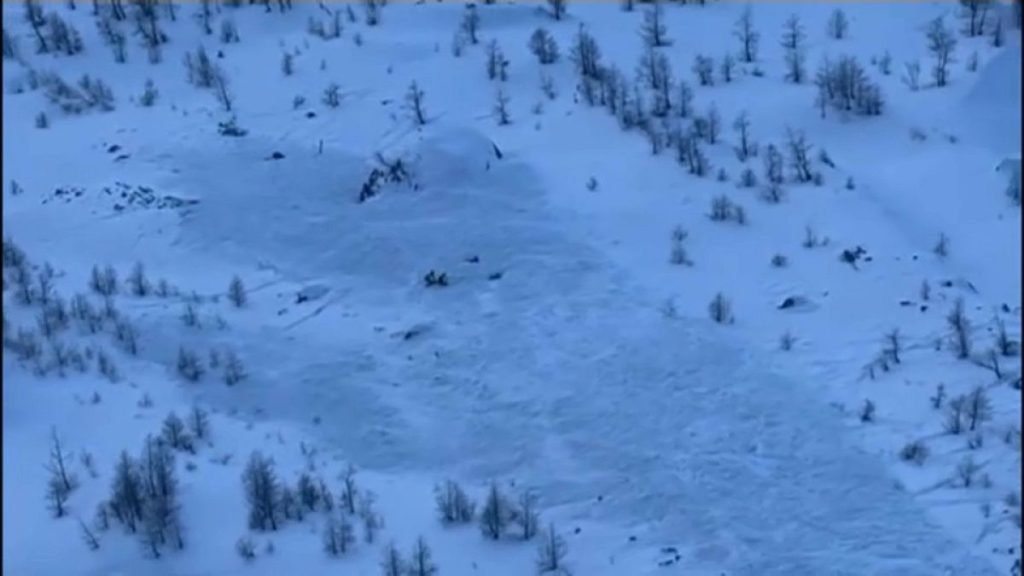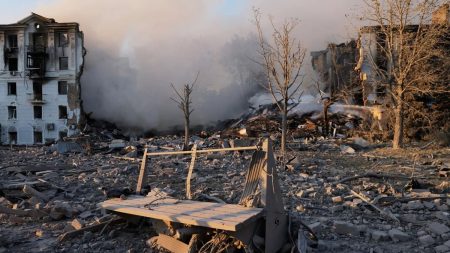The tranquil winter landscape of the Italian Alps was shattered on a fateful afternoon as a devastating avalanche swept down the eastern face of Punta Valgrande, a majestic peak straddling the border between Italy and Switzerland. The powerful surge of snow, unleashed around 12:30 pm, engulfed a group of five skiers who were ascending the mountain, transforming their exhilarating adventure into a desperate fight for survival. The unforgiving force of nature carried the skiers several hundred meters down the treacherous slope, leaving a trail of devastation in its wake. Two members of the group, miraculously escaping the full brunt of the avalanche, were able to summon help and were subsequently airlifted to a hospital for medical attention. However, the remaining three skiers were tragically lost to the mountain, their bodies buried beneath the unforgiving blanket of snow. Recovery efforts were immediately hampered by the challenging terrain and awaited authorization from local authorities, adding another layer of complexity to the already heart-wrenching situation.
The avalanche, a stark reminder of the inherent dangers of mountain environments, occurred despite pre-existing warnings of considerable avalanche risk in the area. Authorities had issued a level 3 alert, on a scale where 5 represents the highest danger level, specifically for areas above 2,100 meters. This warning highlighted the precarious snowpack conditions and the potential for avalanches, urging caution and vigilance among those venturing into the backcountry. While the exact sequence of events leading to the tragedy remains unclear, initial reports suggest the group was ascending the mountain using crampons, specialized equipment for navigating icy terrain, with the intention of skiing down the slopes. Whether the rescuers were alerted by one of the surviving skiers or by witnesses observing the unfolding disaster is yet to be determined.
The incident underscores the importance of respecting the power of nature and adhering to safety guidelines when exploring mountainous regions, particularly during winter. Avalanches, often triggered by a combination of factors including slope angle, snowpack instability, and weather conditions, pose a significant threat to backcountry enthusiasts. Understanding and recognizing the warning signs, such as recent snowfall, rapid temperature changes, and wind loading, can help mitigate the risks associated with avalanches. Carrying appropriate safety equipment, including avalanche transceivers, shovels, and probes, is crucial for self-rescue and assisting others in the event of an avalanche. Furthermore, staying informed about local avalanche forecasts and heeding expert advice is paramount for ensuring a safe and enjoyable experience in the mountains.
The tragic loss of life in the Italian Alps serves as a poignant reminder of the fragility of human existence in the face of natural forces. While the allure of pristine slopes and breathtaking vistas draws adventurers to the mountains, it is essential to balance the pursuit of adventure with a deep respect for the inherent risks. The mountains demand humility and preparedness, and venturing into their domain requires careful planning, sound judgment, and a willingness to adapt to changing conditions. The memory of the skiers lost on Punta Valgrande should serve as a sobering reminder of the importance of safety awareness and the need for continuous education about avalanche risks.
The response to the avalanche highlighted the dedication and bravery of mountain rescue teams who operate in challenging and often perilous conditions. These highly skilled professionals, equipped with specialized training and equipment, work tirelessly to locate and rescue individuals caught in avalanches. Time is of the essence in such situations, as the chances of survival decrease dramatically with each passing minute. The use of helicopters allowed for rapid access to the remote avalanche site, enabling rescuers to quickly reach the surviving skiers and transport them to safety. While the recovery of the deceased skiers presents a more complex and painstaking process, the commitment of the rescue teams to bringing closure to the families of the victims remains unwavering.
The aftermath of the avalanche will undoubtedly leave a lasting impact on the local community and the wider mountaineering community. The tragedy serves as a stark reminder of the unpredictable nature of the mountains and the importance of taking appropriate precautions. As investigations into the incident continue, valuable lessons can be learned and shared to improve avalanche safety awareness and preparedness. By fostering a culture of safety and promoting responsible backcountry practices, future tragedies can hopefully be prevented, allowing individuals to experience the beauty and wonder of the mountains while minimizing the inherent risks. The memory of those lost on Punta Valgrande will serve as a lasting testament to the power of nature and the importance of respecting the mountain environment.














